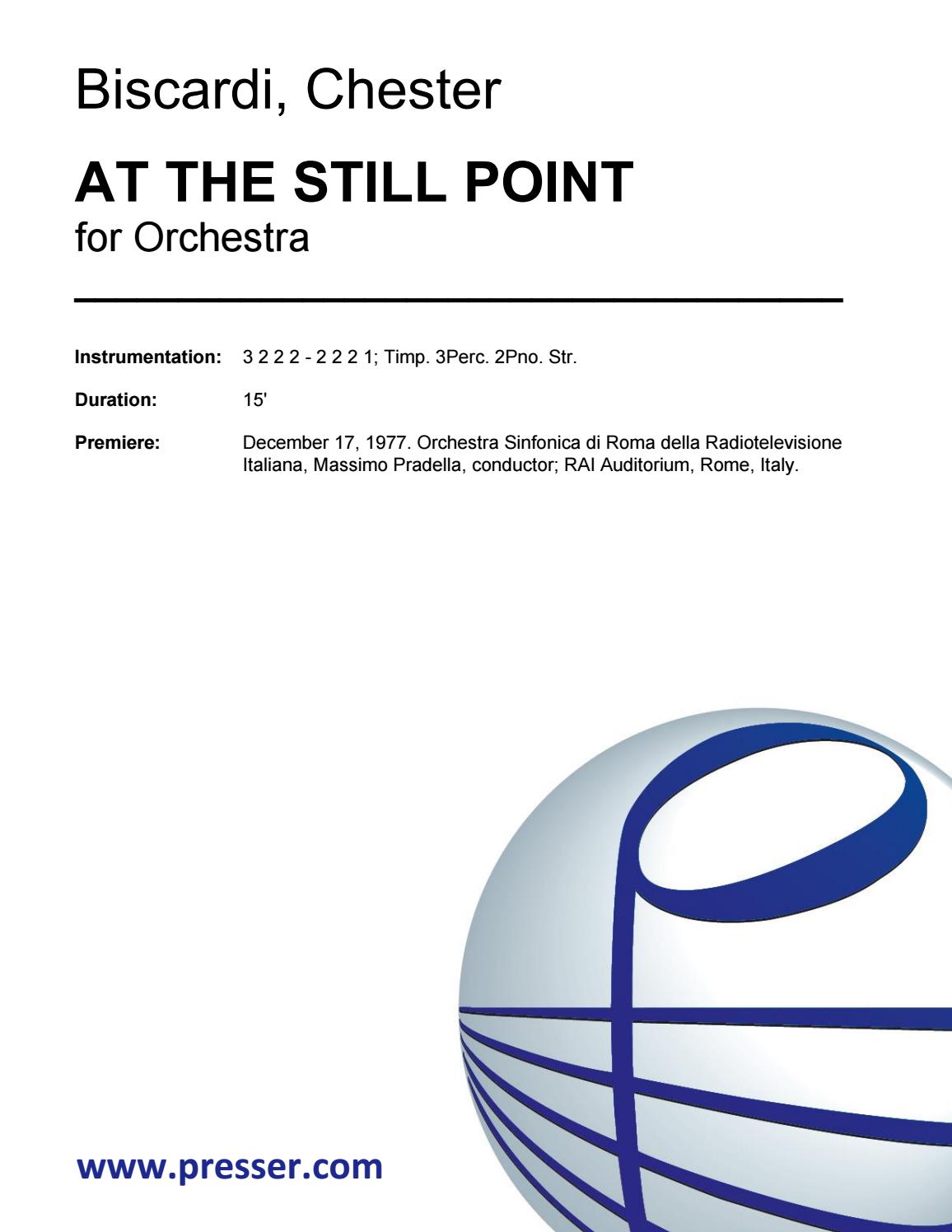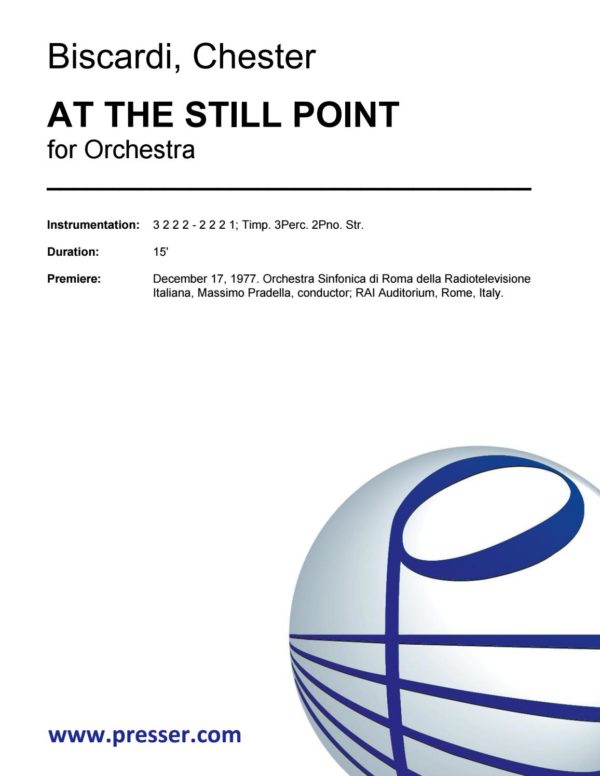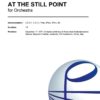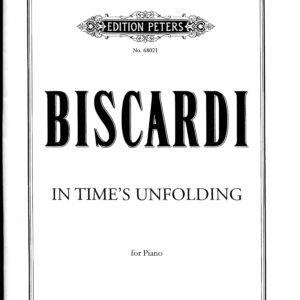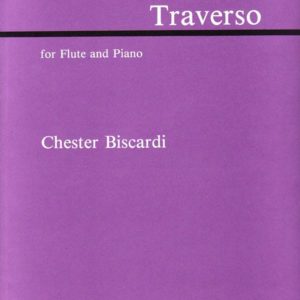Description
Audio
Trio: Jeanne Ingraham, violin
Susan Palma, flute
Gilbert Kalish, piano
American Composers Orchestra
Paul Lustig Dunkel, conductor
This recording appears on
Chester Biscardi: At the Still Point, New World Records/CRI NWCR686 (New York, 1995) with
Traverso,
The Gift of Life,
Companion Piece (for Morton Feldman),
Incitation to Desire (Tango),
Mestiere, and
Tenzone.
Houston Symphony Chamber Orchestra
Premiere
First Performance: 17 December 1977
Orchestra Sinfonica di Roma della Radiotelevisione Italiana / Massimo Pradella, conductor
RAI Auditorium
Rome, Italy
First American Performance: 15 November 1980
Houston Symphony Chamber Orchestra / C William Harwood, coductor
Stokowski Legacy Series: St. Luke Methodist Church
Houston, TX
First New York Performance: 1 February 1982
American Composers Orchestra / Paul Dunkel, conductor
Susan Palma, flute / Jeanne Ingraham, violin / and Gilbert Kalish, piano
Alice Tully Hall
New York, NY
Instrumentation
Four groups:
Highs (2 Fl., 2 Cl., 2 Tpt., 8 Vn., Perc.);
Lows (Ob., E. Hn., 2 Bsn., 2 Trb., Tuba, 4 Vc., 2 Cb., Perc.)
Center (2 Hn., 4 Vla., Perc., Pn.);
Trio (Fl., Vn., Pn.)
Commissioner
for the RAI Orchestra-Rome
Publisher
Merion Music, Inc./Theodore Presser Co. No. 446-41074: Score | Parts
Rental Information (Choose Score and Parts)
Program Notes
At the Still Point, for orchestra (1977), is on rental from Merion Music, Inc./Theodore Presser Co. and is recorded on Chester Biscardi • At the Still Point, CRI CD 686 (New York, 1995). It was written for the Orchestra della Radiotelevisione Italiana in Rome while the composer was a fellow at the American Academy in Rome and was first performed under the direction of Massimo Pradella on December 7, 1977. The American premiere took place on November 15, 1980, with the Houston Symphony, C. William Harwood conducting. This recording for CRI was made following the first New York performance in Alice Tully Hall at Lincoln Center on February 1, 1982.
At the Still Point is scored for an orchestra of forty players divided into four groups: a high group of two flutes, two clarinets, two trumpets, bongos, congas, tom-toms, glockenspiel, vibraphone and eight violins; a low group of oboe, English horn, bassoon, contrabassoon, two trombones, tuba, timpani, tom-toms, timbales, four cellos and two basses; a center group of two horns, four violas, vibraphone, marimba, glockenspiel and piano which connect the two timbral extremes; and a trio consisting of flute, violin and piano which functions at different times as a “drone” and as a group of primary musical importance.
Susan Feder wrote the following in the liner notes for the original issue of At the Still Point:
When Chester Biscardi talks about his music and about his life, sometimes it’s hard to tell where one leaves off and the other emerges. “For me writing music is part of a continuing process of awareness – of self and of trying to make an intellectual and emotional connection to the world,” he says. In his music, one concern is with “space – registral and physical – and how that generates the form of a work.” Another is with timbral bridges, which connect diverse sonorities, and a third is with “‘frozen registration,’ when I keep a tone in a certain place until, for motivic or harmonic reasons, I intuitively feel that it must move.” In his teaching at Sarah Lawrence, he urges his own students toward an integrated, intuitive approach to composition.
Literature has given him ideas about form. The titles of his works provide clues to the sources of inspiration. The percussion piece Trasumanar (1980) stems from Dante; Tenzone (1975), for flute duo and piano, comes from a Provençal poetic form structured by means of dialogue; Mestiere (1979), for piano, and Di Vivere (1981), for clarinet and piano with flute, violin and cello, make up the title of an Italian journal called The Business of Living.
“At the still point” is a line from T. S. Eliot’s “Burnt Norton,” a poem dealing with the interplay of form with time, the “still point” being where past and future meet. Biscardi was well into the composition of the work before realizing that its compositional elements – particularly the acoustical and timbral interplay of the four orchestra groups, and the whys and whens of pitch change – reminded him of the poem, and he made use of a solo violin toward the end of the piece in a direct evocation of one of Eliot’s images. The placement of the four orchestral groups “allows the music to flow in a certain spatial way,” and accounts also for the pulling of the pitches into and out of their frozen registration. Biscardi also found that his “technique of dealing with form comes from a constant referral back to material already presented, a reevaluation of musical ideas which are continually related in a new context–a process which attempts to incorporate past as well as future ideas in the present moment.”
Press
"Biscardi drew his inspiration from poetry, turning to Eliot and transforming into music a play of contrasting tensions by which the sounds expand and contract in a mobile fixity. The orchestra is subdivided into four sections and even on this level, the work functions perfectly."
— Erasmo Valenti, L'unità (1977)
"Here one heard at work experienced craftsmanship. The play of timbral contrasts and durational values had an appealing, suggestive quality."
— Dino Villatico, La repubblica (1977)
"The work by Biscardi was precise and stimulating. It was a world premiere, and the composer, present in the auditorium having reaching a European concert hall early in his career, was warmly applauded."
— Virgilio Celletti, Avvenire (1977)
"Chester Biscardi's AT THE STILL POINT, the new American work on the Stokowski Legacy series, emplyed the antiphonal format of pitting soloists against a larger group. It is a tense, emotionally volatile work, exploring different possible coloring of tones and often quite dissonant harmonic clusters. Quite haunting. A convincing first U. S. Performance Saturday."
— Carl Cunningham, The Houston Post (1980)
"The New York premiere of Chester Biscardi's 'At the Still Point' was a serious, introverted exploration of musical time and movement."
— Nicholas Kenyon, The New Yorker (1982)
"AT THE STILL POINT (1976/77) is a piece by a highly regarded young composer, Chester Biscardi. Working mostly in chamber music forms and an atonal framework, Biscardi writes music with a signature vividness and intensity that seems interestingly to spring from a basically lyrical temperament — it's music that can be active and even disjunct from one moment to the next, but the overall effect is one of directed, sustained flow. The registral and geographical arrangement made for interesting interplay as the material ebbed and flowed between the various groups, or the groups themselves combined. Its best moment was an exquisite middle section in which the music slowly and inevitably phased itself out, a lovely exercise in suspended time."
— Linda Sanders, The Soho News (1982)
"AT THE STILL POINT, which takes its title and its ideas of motion around stillness from T. S. Eliot's BURNT NORTON, holds interest by keeping a focus on long, big buildups of tension. That, in turn, enhances the ethereal rounding-off at the end. The performances are altogether superb. A PLUS"
— Leighton Kerner, The Village Voice (1982)
"Biscardi's 'At the Still Point' is an impressionistic essay in symphonic textures and sonorities."
— Harry Haskell,, Kansas City Star (1982)
"The Biscardi is a mystical excursion into sound and space."
— Rad Bennett, Washington Tribune (1983)
"Here's a fine opportunity to hear an approach to the current problem facing young composers: how to express emotional content without turning to the false nostalgia of postmodern tonal music. Biscardi is exploratory, concerned with sonics and sonorities rather than melodies and chords, but just as dramatically expressive — perhaps more so by virtue of its avoidance of cliché."
— Charles Shere, The Oakland Tribune (1983)
The orchestral work [
At the Still Point (1977)] was written while Biscardi was in Rome, and shows in particular the influence of Elliott Carter. While the general harmonic rhythm of the piece is slow, the sharply outlined details of individual lines and the emphasis on particular intervals reiterated in similar contexts combine to remind one of similar moments in Carter (in my case, I thought of the slow-moving blocks of sounds in that composer's piano concerto).
— Robert Carl, Fanfare, The Magazine for Serious Record Collectors (1995)
At the Still Point, for orchestra and trio (1977), utilize[s] the technique of "frozen registration." Harmonies don't logically flow from one moment to the next, leaving the listener not unpleasantly trapped in a never-ending present tense. Like Debussy, Biscardi uses instrumental timbre and dynamic variation as structural elements.
— William Zagorski, Fanfare, The Magazine for Serious Record Collectors (1995)
"Chester Biscardi is a professor of music at Sarah Lawrence College in New York. This disc presents a survey of his works for soloists, chamber ensemble, and orchestra from the mid-1970s through the mid-1990s. Though his musical voice has evolved and changed through those years, each work presented here displays a moment of inspiration, a gentle and compassionate spirit, a captured moment in time — at the still point."
— CRI Comminiqué (1995)


